Behind Bard is a Google that understands products.
Author: Mu Mu
Editor: Wen Dao
Half a year later, Bard, which was once overshadowed by ChatGPT, released a major update, integrating data from Google's suite of office applications such as Gmail and Docs. It supports one-click saving of AIGC content to Google's ecosystem, including email, documents, spreadsheets, and more. It also added a "Google it" self-verification feature in the conversation interface to avoid the illusion bug in the chatbot.
In fact, Bard has been iterating since its launch, with new versions released almost every month, constantly adding features such as voice input and directly providing images that were previously only accessible through search engines based on user text commands.
Based on personal testing, the new version of Bard is becoming more like an internet product by connecting to Google's rich ecosystem of applications. This makes the chatbot more practical and demonstrates the scalability of this type of large model product to the outside world.
Bard, once embarrassed, is moving towards the direction of an AI assistant and is no longer just a chatbot like ChatGPT.
01 Bard Update Deeply Integrates Google Applications
Do you remember Bard, the chatbot that failed at the Google launch event in February this year? At that time, it mistakenly associated the "first photo of an exoplanet taken by a telescope outside the solar system" with the "James Webb Space Telescope," which was corrected to be "Very Large Telescope," leading to ridicule and criticism from the tech community for its "hasty" and "self-exposing" actions in the AI arms race against Microsoft.
Now, half a year has passed, and the heat around AIGC has decreased, but Bard released a major update in September called "extension plugins," integrating applications and data from Gmail, Google Docs, YouTube, Google Drive, Google Maps, and Google Flights.
As you can see, this update from Bard is a deep integration with Google's data and application market. Through this plugin, Bard can directly access data from Google's email, documents, videos, cloud storage, maps, and flights applications, and then generate content based on user needs.
What kind of user experience upgrade can a chatbot provide by directly accessing application data? We will answer this question with examples.
For example, when you want to create a travel itinerary, Bard can read relevant travel information from your Gmail inbox, find the most suitable departure date, and use Google Flights and hotel information resources to provide you with real-time and practical flight and hotel options. Bard also emphasizes that the chatbot will not invade your personal privacy or use your data for training purposes.
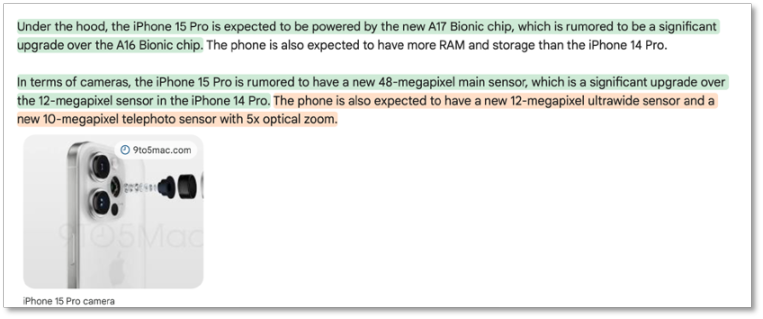
Green content is more credible than yellow content
The most criticized aspect of chatbots has always been their nonsense. Now, Bard is trying to fix this flaw by integrating with search engines and launching a verification feature. By clicking "G," Bard can self-check for errors, allowing the chatbot to "admit mistakes and make corrections." What's even more advanced is that Bard will indicate which content is more credible, which contradicts the search results, and provide source links.
On the mainstream path of transforming from a chatbot to a creative assistant, Bard is also strengthening its integration with Google's existing products.
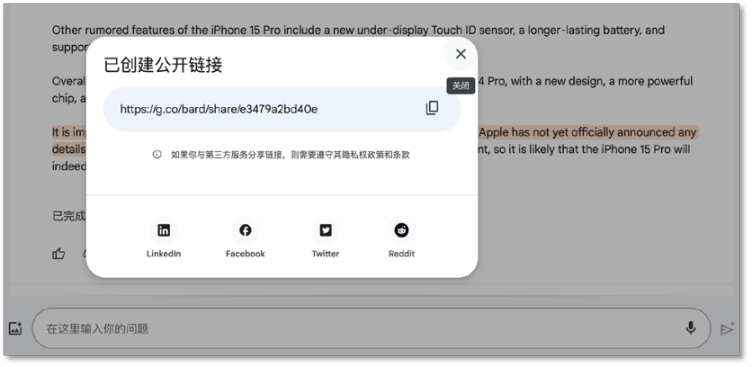
Share conversation links to invite others to join the discussion
If you are a tech writer, you can ask Bard to write a review of the iPhone 15. Now, it can save the review to Google Docs with one click for you to revise and edit. If you feel the content is too subjective, you can also share the current conversation link on LinkedIn, Facebook, Twitter, and Reddit to invite others to join the discussion. Even if the conversation stops for a while, the discussion can still be continued.
You can also ask Bard to generate a data table for a financial report of a listed company and receive data analysis from the chatbot, such as the source of the company's revenue growth. Of course, you can also ask Bard to be "more professional," "concise," "detailed," "relaxed," or "simple," which is already a basic operation for online chatbots on the market. The extended function of Bard is that it can be exported to a table with one click for users to edit charts in office software.
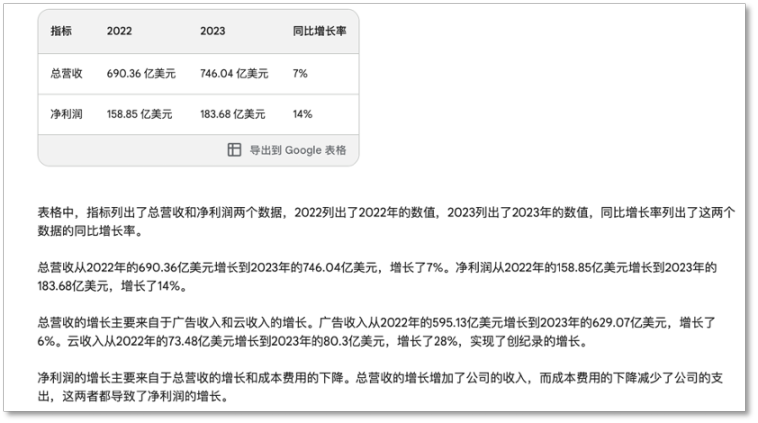
Bard directly generates tables and analysis in one step
After the September update, Bard is becoming more like a powerful AIGC product, no longer just a question-answering machine. In fact, Bard's current performance is the result of continuous updates since April this year, with almost monthly updates focusing on "adding features."
For example, on May 10th, Bard added a one-click option to directly export generated content to Google Docs and Gmail. You can ask Bard to generate a cover letter and save it to the Gmail draft box with one click, making it easier to send it to the HR email address without the hassle of "copy and paste."
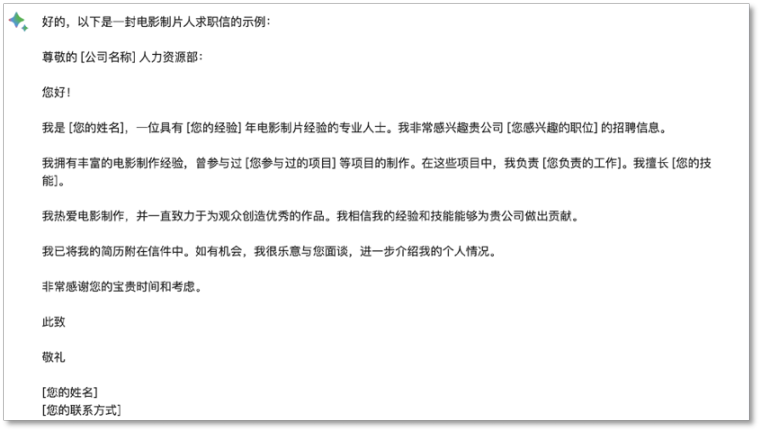
Bard can be an efficient work assistant
On June 7th, Bard's generated charts can be exported to Google Sheets. On July 13th, Bard removed the restriction on the use of new features to "English only," adding more than 40 new languages, including Arabic, Chinese (Simplified/Traditional), German, Hindi, and Spanish.
In August, Bard can recognize images. Using Google's smart camera, users can upload images, and this chatbot can understand internet meme images and even present a proper perspective in the analysis.
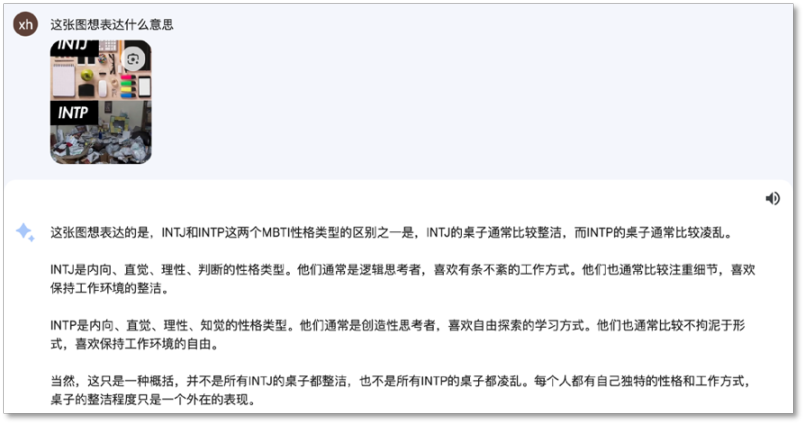
Bard can understand meme images too
It can be seen that the deep integration with Google's products is making Bard more and more like a qualified internet product, focusing on practicality, user scenarios, and user experience. The AIGC field has finally turned from a big model arms race to a more user-friendly product.
02 Giants Transition from Big Models to AIGC Products
Having an internet company that understands products as its "parent company" is Bard's biggest advantage compared to ChatGPT. It allows the large model product like a chatbot to directly integrate with its own G-series products, achieving advancement. It can not only become a powerful and sustainable independent product but also enable Google's existing products to be AI-upgraded.
In contrast, OpenAI's GPT can tend to fully disclose its capabilities to its shareholder Microsoft, allowing Microsoft's applications to quickly integrate AI. But as an independent product upgrade, ChatGPT relies solely on OpenAI's team, which focuses on large models.
Currently, to implement search functionality, ChatGPT needs to upgrade to the Plus version and use browsing plugins. BingChat, on the other hand, is powered by GPT to provide conversational AI functionality in the Bing browser. Now, the upgraded Bard demonstrates the potential of an independent product, with performance capabilities that resemble a combination of ChatGPT Plus, Bing, and BingChat, effectively doubling its combat power.
In terms of development trends, after the model and computing power frenzy in the first half of 2023, people are gradually calming down from the AI technology craze and turning towards innovative applications and ecosystem development in generative AI.
The actions of major companies are confirming this trend. Not only abroad, but domestic companies like 360 Brain and Tongyi Qianwen have recently chosen to open up to the public in the form of applications and ecosystems.
On September 21st, 360 Brain's "full suite" officially opened to the public. Currently, 360 Brain has integrated with 360's full range of products and will continue to open up intelligent creation, intelligent office, intelligent social, intelligent management, intelligent marketing, and other life and work scenarios in the future.
Alibaba's Tongyi Qianwen is also following a similar path. The first businesses to integrate with Tongyi Qianwen are DingTalk and Tmall Genie, targeting collaborative office and smart home traffic. After integrating with Tongyi Qianwen, DingTalk can already generate work plans and automatically generate summaries and to-do lists after meeting minutes. Tmall Genie focuses on solving problems in daily life scenarios.
Global internet technology giants are rolling out applications, each showcasing their strengths in various scenarios, showing a trend of unstoppable momentum. Cracks in the market are beginning to appear, and ChatGPT's first-mover advantage is no longer as obvious. According to Reuters data, the average time spent by visitors on ChatGPT has decreased from 8.7 minutes in March to 7 minutes in August.
The continuous emergence of competing products is undoubtedly one of the reasons for the shortened user retention time on ChatGPT. Now, Bard has given users a new choice, and its significant advantage after deep integration with Google applications is that Google's software has already accumulated a massive user base, which is much more convenient than trying to attract traffic for a new product.
"Rolling up" is probably what all users who have become accustomed to using AIGC tools are most looking forward to, because only competition can make products more functional and cost-effective. It is recommended that major and minor AIGC companies in China quickly align with Google, deeply integrate with Microsoft, and compete to reach new heights and achieve new levels.
免责声明:本文章仅代表作者个人观点,不代表本平台的立场和观点。本文章仅供信息分享,不构成对任何人的任何投资建议。用户与作者之间的任何争议,与本平台无关。如网页中刊载的文章或图片涉及侵权,请提供相关的权利证明和身份证明发送邮件到support@aicoin.com,本平台相关工作人员将会进行核查。




